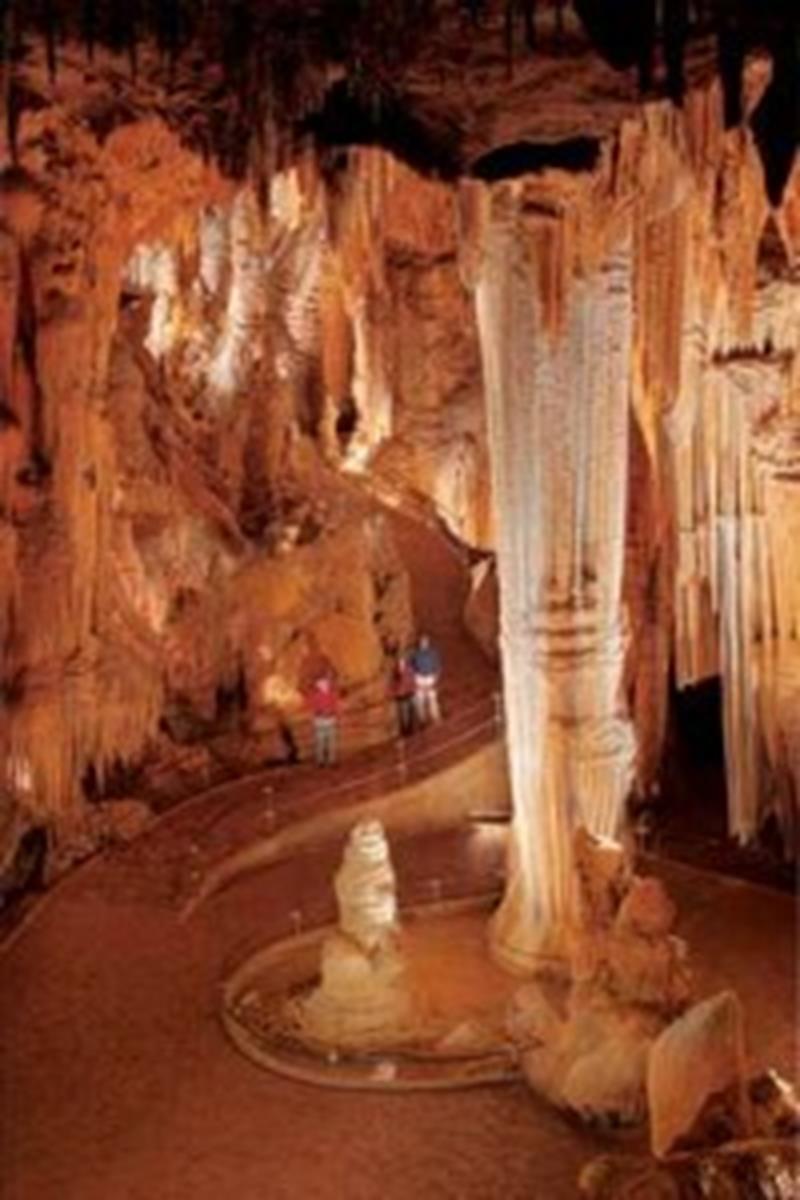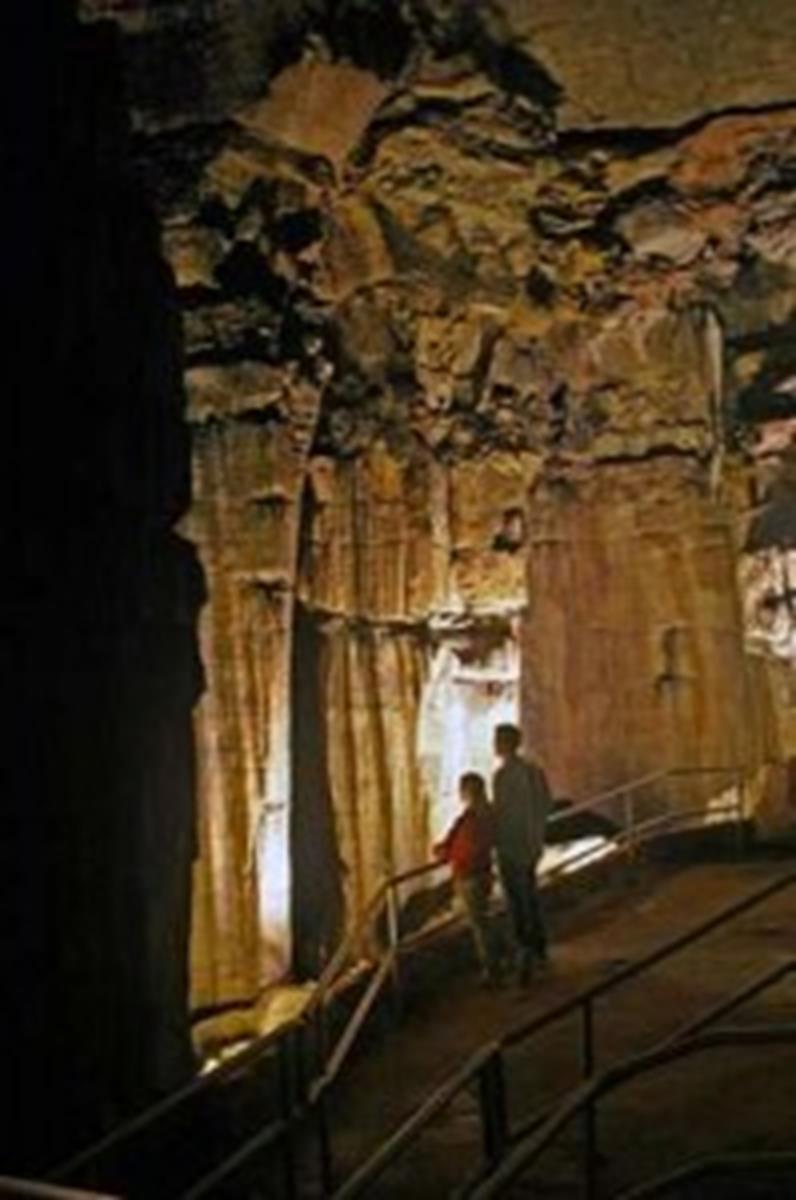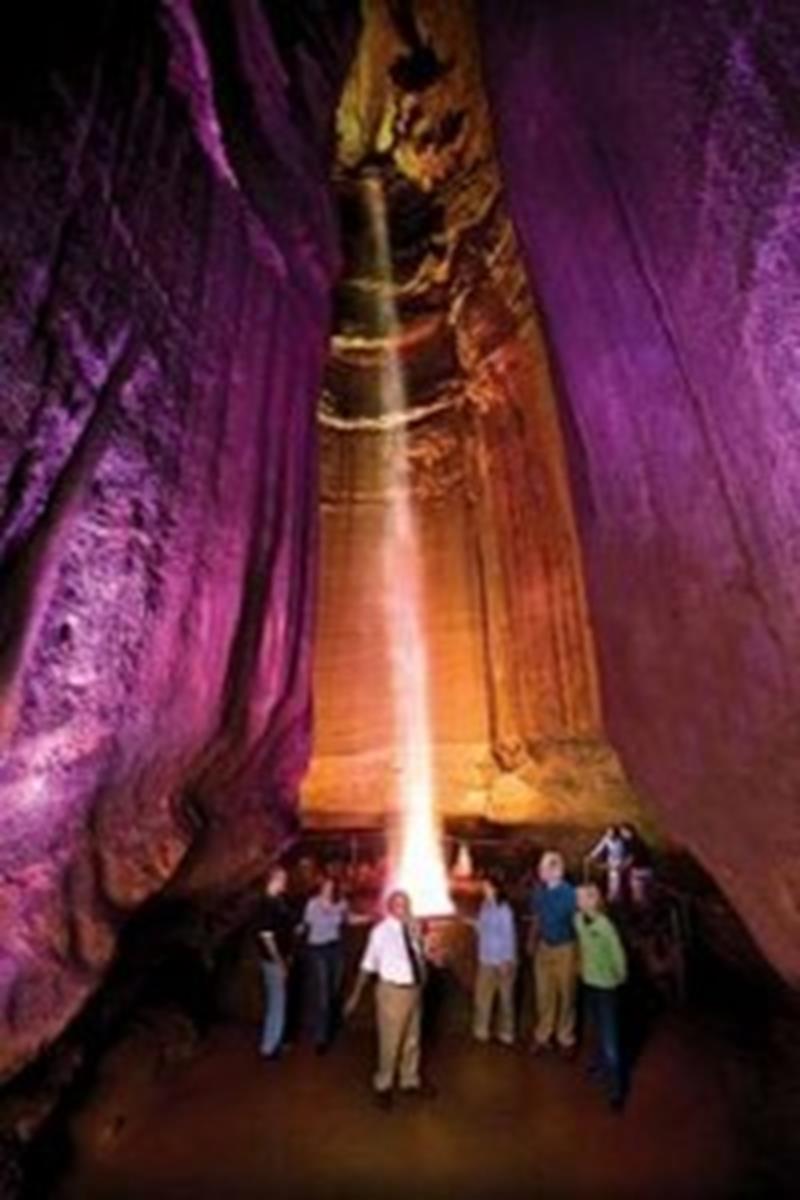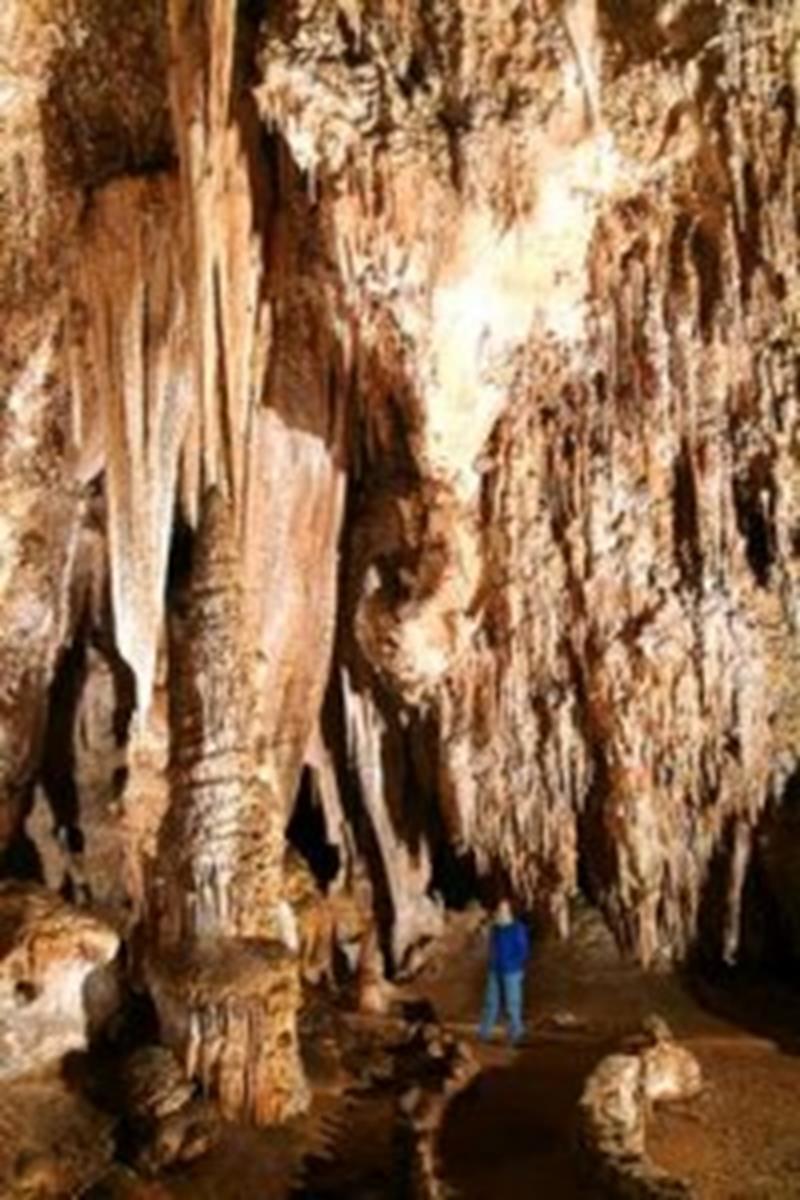But to a new, environmentally aware generation, these spectacular underground chambers are seen as precious natural wonders…literally buried treasures. For student travel groups, a cave tour is educational as well as just plain fun. Many caves, in fact, offer educational programs related to geology, hydrology and archeology.
On a hot summer’s day, caves offer relief from the heat, as most of these “air-conditioned” vaults can be a bit chilly, with temperatures hovering between a constant 49 to 60 degrees. The big draw, however, are the dream-like formations in galleries, grottoes, alcoves and canyons lavishly decorated by Mother Nature and enhanced by manmade illumination. Listen to the tour guide, use your imagination and see shimmering sculpted rock in the form of totem poles, ant hills, statues, draperies, icicles, frozen waterfalls, even bacon and fried eggs. Many formations are still growing and glisten with moisture. (Just to refresh your memory—stalactites point their craggy fingers down from the ceiling, while stalagmites struggle up from the floor.)
Here are eight caverns that would enhance any student travel itinerary:
Luray Caverns
Luray, Virginia
This Shenandoah Valley attraction, in the foothills of the Blue Ridge Mountains, is the most visited cave in the East. In the Cathedral Room, its Great Stalacpipe Organ (purportedly the world’s largest musical instrument) produces music of symphonic quality when electronically controlled rubber-tipped plungers strike stalactite formations covering 3½ acres of surrounding walls. Hour-long tours take groups past towering stone columns, crystal pools and formations with names like Totem Pole, Titania’s Veil and Frozen Fountain. Luray Caverns also has the Singing Tower (a 47-bell carillon) and an antique car/carriage museum.
Meramec Caverns
Stanton, Missouri
Nestled in the Ozark foothills along the Meramec River, this well-advertised cave is just over an hour from downtown St. Louis. Favorite formations on the 80-minute tours include the Wine Table and Stage Curtain. Jesse James and his gang once used the cave as a hideout. The riverfront offers camping, canoeing and sightseeing cruises. Or soar through the trees on an hour-long zip line adventure. Educational programs in an underground classroom cover such topics as rocks and minerals, fossils, hydrology and topography.
Mammoth Cave National Park
Mammoth Cave, Kentucky
The world’s longest known cave system boasts more than 400 miles of passageways on five levels. The tallest dome is 192 feet high, the deepest pit 105 feet. Popular formations and rooms include Mammoth Dome, the Rotunda, Ruins of Karnak and Frozen Niagara. Tours, from 1¼ to 6 hours, range in degree of difficulty. The wild cave adventure requires crawling, climbing and walking off the beaten path. The Green and Nolin rivers course more than 30 miles through Mammoth Cave National Park, offering hours of boating, canoeing and fishing.
DeSoto Caverns Park
Childersburg, Alabama
During the Civil War this cave was used by Confederates for mining saltpeter for gunpowder, and it was a speak-easy and square dance hall during Prohibition. Hour-long tours include a laser light and water show in the Great Onyx Chamber, which is larger than a football field and higher than a 12-story building. Above-ground activities include gemstone panning, water balloon battles, a squirt gun maze, and cave-wall climbing. Special school group packages offered from December thru February involve the study of cave hydrology, geology and archeology, with a special lantern lit tour of the caverns – the way the early explorers used to see the cave. An Educational Enhancement Guide with materials meeting Alabama state standards can be downloaded. Overnight sleepovers are available for groups of 20 or more.
Ruby Falls
Chattanooga, Tennessee
Each year 400,000 visitors go inside America’s deepest commercial cave (1,120 feet below the surface) and see the thundering 145-foot waterfall flowing out of its roof. Bathed in a colorful LED light display accompanied by music, it’s said to be the nation’s largest underground waterfall open to the public. Guests are encouraged to walk behind the falls. Located deep inside Lookout Mountain, in a vaulted dome room known as Solomon’s Temple, the roaring cascade was named for the wife of the man who discovered it in 1928. Along the way you encounter countless whimsically named rock formations like the Elephant’s Foot and Bacon and Potato Chip, and are led through on trails like Weight Watchers Lane and Twilight Zone. Educational materials are available for school groups.
Jewel Cave National Monument
Custer, South Dakota
This cave in the Black Hills of western South Dakota is believed to be the third longest cave in the country, with more than 166 miles of mapped and surveyed passages. Its chambers are noted for the nailhead calcite crystals lining the walls. The largest room discovered is called the Big Duh. It measures 570 feet long, is 180 feet wide at its widest point, and is 30 feet tall. There are four types of ranger-guided tours. Your group can choose from the easy, 20-minute Discovery Tour, the moderately strenuous, 80-minute Scenic Tour, the more strenuous Historic Lantern Tour in which participants carry candle lanterns (one hour, 45 minutes), and Wild Caving Tour for hardy explorers who are given hard hats with headlamps (three to four hours, limited to five persons).
Carlsbad Caverns National Park
Carlsbad, New Mexico
In Carlsbad Cavern, the main cave, some of the ceilings arch up to 25 stories, while the Bottomless Pit, a monstrous black hole, plunges 14 stories down. One chamber, the eight-acre Big Room, is the length of six football fields. At dusk from mid-May to mid-October, hundreds of thousands of bats spiral out of the cave to feed on insects along the Pecos and Black rivers. Park rangers give a talk at the cavern entrance amphitheater prior to the flight. Guided cave tours range from easy walks to difficult crawls and climbs. The park offers curriculum-based materials for students of all ages. For high school students, the Chihuahuan Desert Lab offers hands-on participation in resource monitoring and stewardship activities at the park. Also available is a high school geology curriculum guide, as well as three curriculum guides for middle school classes on geology, ecology and biology.
Natural Bridge Caverns
Texas, Hill Country
Located 30 minutes north of San Antonio, this is the largest show cave in Texas. Tours showcase glistening, delicate soda straws and waves of colorful cave ribbons, along with chandeliers, flowstones, stalagmites and stalactites. Ask about lesson plans that follow state education guidelines. For the brave, there is the Hidden Passages Adventure tour, a three- or four-hour excursion where explorers climb, crawl and rappel with only the light of their helmet to guide them. Once outfitted with caving gear, participants are lowered by rope through a 160-foot well shaft. Above ground, the caverns also offer a Canopy Challenge adventure course and four zip lines.
(www.naturalbridgecaverns.com)
−By Randy Mink









